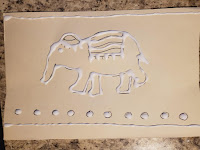Thailand ended up being a really fun country to study. There are so many amazing Thai recipes to try and lots of neat buildings and monuments to learn about. My family's favorite part of this unit study was learning about Asian elephants, they are such interesting and intelligent animals!
Basic Information
Thailand is a country in southern Asia. It is boarderd by Cambodia, Laos, Myanmar, and the Andaman Sea. The northern region is mountainous while the southern region is hilly and forested.
Capital- Bangkok
Population- 69.6 million
Size- 198,115 square miles
Currency- Baht
Type of Government- Constitutional Monarchy
National Anthem- Phleng Chat Thai
National Animal- elephant
Flag
Famous Places
The Grand Palace- The Grand Palace in Bangkok was used as the official royal residence of Thailand from 1782 to 1925. It is still used today for ceremonies and state functions. The palace sits on the banks of the Chao Phraya River. It consists of many buildings and pavilions set around a complex of courtyards and gardens.
-Here is a short video tour of the palace grounds: https://youtu.be/UunewAC_n6I
Wat Arun- Wat Arun, which is short for Wat Arun Ratchawararam Ratchaworamahawihan (you can hear that pronounced here), is a Buddhist temple in Bangkok, Thailand. The name is derived from the Hindu god Aruna. It's gorgeous and unique architecture makes it a popular tourist attraction.
-Here's a short video tour: https://youtu.be/KN56TwTrYVw
Railay Beach- Railay Beach is one of the world's most beautiful beaches. It's located on a small peninsula in southern Thailand and is accessible only by boat because of the high limestone cliffs surrounding it.
Recipes
We made some simple Thai style mango ice cream and it was a big hit with all three of my kids.
Here's the recipe we used: Easy Mango Ice Cream. Since we couldn't find any fresh mangos here this time of year, I tweaked the recipe a little and substituted some Bolthouse Farms Amazing Mango smoothie for the juiced mango.
And here are a couple more Thai recipes to try:
-Chicken Pad Thai (My favorite Thai dish)
Crafts
Lotus Flower Craft
There is a lake in northeast Thailand known as The Red Lotus Sea because so many lotus flowers grow in it. You can watch a short video about it here: The Red Lotus Sea.
Then try making your own paper lotus flowers! To make this craft you will need:
-A paper plate
-Pink or red construction paper
-Green paint or a green marker
-Yellow tissue paper or construction paper
-A pencil
-Scissors
-Glue
Start by painting or coloring the paper plate green. When it's dry, cut a small wedge from edge to the center. Discard the wedge and set aside the green paper plate to use later.
Sketch some flower shapes of different sizes onto the construction paper and then cut them out.
Stack several of the flower cut outs with larger ones towards the bottom and smaller ones on top. Then glue them together in the center so that they stay stacked but the petals are still free.
Wrap the petals around a pencil to curl them towards the center, then glue your flower to the center of the green paper plate.
Crumple up a small piece of yellow tissue paper or construction paper and glue it to the center of your flower.
Asian Elephant Craft
Asian elephants are important to the Thai people. They are often used as work animals to move heavy loads or to transport people.
Learn more about Asian elephants with this short video from Animal Fact Files: Asian Elephant Facts: Gentle Giants
Since Asian elephants are often depicted in Thai art, we thought it would be fun to do a craft that incorporated elephants.
For this craft you will need:
-A file folder
-Aluminum foil
-Glue
-Permanant markers
-Paints (tempra or acrylic)
-Scissors
-A pencil
Start by cutting your file folder in half and then in half again so that you have 4 equal sections. You will only need one of these sections.
Sketch the shape of an elephant onto the section of file folder, then trace your drawing with school glue. You want the glue to be fairly thick. Then set it aside to dry.
When the glue is fully dry, take a piece of aluminum foil big enough to cover the front side of your section of file folder and wrap around each each side. You can tape it in place on the backside if you want to, but we found that it wasn't necessary.
Gently rub over the aluminum foil on the front side of your project with your fingers until the image of the elephant can be seen.
Trace the elephant with a black permanent marker, then add detail to your elephant and decorate the background with permanent markers or paint. Then set it aside to dry again.
Additional Resources
Websites:
-Thailand from National Geographic Kids
-Thailand Facts from Kids World Travel Guide
Videos:
-Are We There Yet? Thailand Tigers from National Geographic Kids
-Are We There Yet? Bangkok from National Geographic Kids
Books:
-Animal Abilities: Elephants by Charlotte Guillain
-Thai Children's Favorite Stories: Fables, Myths, Legends, and Fairy Tales by Marian D. Toth and Patcharee Meesukhon
If you enjoyed this post check out some of my unit studies for other countries:
Follow me on:
















Comments
Post a Comment